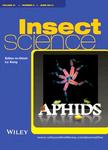Indirect plant defense against insect herbivores: a review
Indirect plant defense against insect herbivores: a review作者机构:Department of Entomology Kansas State University Manhattan Kansas USA Hard Winter Wheat Genetics Research UnitUSDA-ARS Kansas State University Manhattan Kansas USA
出 版 物:《Insect Science》 (昆虫科学(英文版))
年 卷 期:2018年第25卷第1期
页 面:2-23页
核心收录:
学科分类:0710[理学-生物学] 07[理学] 09[农学]
主 题:elicitor indirect plant defense natural enemies volatile
摘 要:Plants respond to herbivore attack by launching 2 types of defenses: direct defense and indirect defense. Direct defense includes all plant traits that increase the resistance of host plants to insect herbivores by affecting the physiology and/or be- havior of the attackers. Indirect defense includes all traits that by themselves do not have significant direct impact on the attacking herbivores, but can attract natural en- emies of the herbivores and thus reduce plant loss. When plants recognize herbivore- associated elicitors, they produce and release a blend of volatiles that can attract preda- tors, parasites, and other natural enemies. Known herbivore-associated elicitors include fatty acid-amino acid conjugates, sulfur-containing fatty acids, fragments of cell walls, peptides, esters, and enzymes. Identified plant volatiles include terpenes, nitrogenous compounds, and indoles. In addition, constitive traits including extrafloral nectars, food bodies, and domatia can be further induced to higher levels and attract natural enemies as well as provide food and shelter to carnivores. A better understanding of indirect plant defense at global and componential levels via advanced high throughput technolo- gies may lead to utilization of indirect defense in suppression of herbivore damage to plants.



